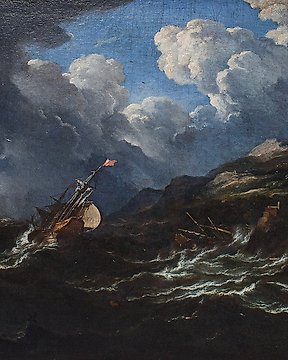
Matthieu van Plattenberg, detto Monsù Montagna (1608 - 1660) - Burrasca con velieri
Nr. 83215361

Nr. 83215361

This spectacular painting, dating from the 1630s, is a remarkable product of the Utrecht Caravaggist school. It is part of a group of depictions of the death of Seneca by northern artists who had travelled to Italy and were influenced by Italian painting both in terms of style and choice of subjects, often inspired by classical antiquity. The first to treat this subject, around 1625, was Gerard van Honthorst (1592-1656), followed a few years later by Matthias Stomer (1600-1650), Joachim von Sandrart (1606-1688) and Jacques de l'Ange (1621-1650).
Joachim Sandrart, born in Frankfurt to a Flemish family, went to Prague as a teenager to learn the art of engraving from Aegidius Sadeler. But in 1624 Sadeler, realizing his precocious talent as a painter, encouraged him to move to Utrecht where he became a pupil of Gerard van Honthorst. Through Honthorst, in 1627 he met Pieter Paul Rubens who recruited him for collaboration on part of his Maria de' Medici cycle. Rubens too was to exert a certain influence on his style, which is conspicuous in his mythological paintings. Subsequently Sandrart began his journey to Italy where he remained for a decade living mainly in Rome. By the time he returned to the Dutch Republic in 1637, he was a highly regarded artist. He spent most of his adult life in Amsterdam until 1672.
We know that Sandrart produced at least two depictions of the death of Seneca, based on Tacitus's famous description in Book XV of the Annals. Besides this recently discovered painting, there was a different one, commissioned by Marquis Giustiniani and destroyed at the end of World War II in the fire of the Flakturm Friedrichshain together with 400 other pictures from Berlin's Gemäldegalerie. Compared to the other version, of which only a black-and-white photograph survives today, this one is distinguished by the strong caricature vein with which the characters' feelings are rendered, their expressions emphasized by the candlelight. By making the torment of the disciples and the complacency of the guard coexist in the same snapshot of Seneca's drama, with a language similar to that of the modern theatre of the absurd, the artist clearly intended to satirize Nero's foolish decision to put the righteous philosopher to death.
We thank Dr. Christian Klemm for his help in cataloguing the painting and Dr. Bernhard Schnackenburg for suggesting its dating.
TECHNICAL DETAILS:
Oil on canvas, 153 x 117 cm. The remarkable period frame that comes with the painting is offered as a courtesy.
#gallerycorner
Cum să cumperi de la Catawiki
1. Descoperă ceva special
2. Plasează cea mai mare ofertă
3. Fă o plată sigură